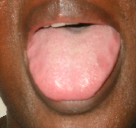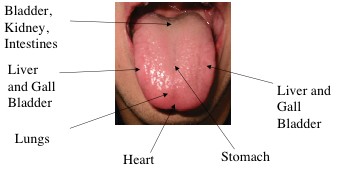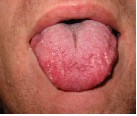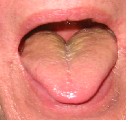Positive Health Online
Your Country

Show Me Your Tongue
listed in chinese oriental medicine, originally published in issue 148 - June 2008
When I was young I was sent to bed for sticking out my tongue. Now I am an acupuncturist, I ask my patients to do it. How ironic! Tongue diagnosis is a very important diagnostic tool, and the tongue can sometimes signal disease before any other signs and symptoms have manifested.
What Do We Observe?
The tongue lives inside the mouth, but it is one of the few places where Chinese medicine practitioners can see the state of their patient’s internal Organs – but on the outside of the body. Everyone’s tongue is different – like fingerprints.
The colour, shape, moisture, movement, coating and areas of the tongue are all important. A healthy tongue is pale red, fairly moist, fits snugly into the mouth and has a thin white coating. Below are some of the most common observations practitioners make.
Colour
Colour is a very simple and accurate way of diagnosing a patient’s internal temperature and state of the Blood. As I said above, pale red is the normal tongue colour. If the tongue looks redder than normal, this shows the presence of heat. A pale tongue indicates cold or Blood deficiency. The tongue is filled with Blood, so it will naturally become paler when Blood is deficient. An orangey colour can also indicate Blood deficiency – especially at the sides of the tongue body. A purple tongue usually indicates Blood stagnation within the body.
I should say here that ‘Blood’ in Chinese medicine is slightly different to ‘blood’[1] in Western medicine. Although Blood in Chinese medicine contains the concept of the substance running through our blood vessels, it also has additional functions. The main functions are to nourish and moisten the body and settle the spirit. Signs and symptoms such as dryness, cramps, pins and needles, breaking nails, anxiety, palpitations and jumpiness, can all arise because these two functions are affected, due to the Blood being deficient. Blood can also stagnate. One common symptom of Blood Stagnation is a purple colour showing on the lips or nails, or pain such as period pains.
Areas
Each area of the tongue corresponds to a different organ in the body. As you can see in Figure 1, the rear of the tongue shows the functioning of Organs in the lower body, whilst the tip represents the Organs higher up – the Heart and Lungs. The Organs that are in the middle area of the body – Stomach, Spleen, Liver and Gall Bladder, are placed in the middle area of the tongue. 
Figure 1 : This patient's tongue is very pale confirming her diagnosis of coldness (or yang deficiency) and some Blood deficiency. Note the swelling of her tongue with toothmarks – see 'shape' below
These areas (Figure 2) may be wet or dry, thin or swollen, pale or red according to which Organ of the body is out of balance. For instance, red sides of the tongue can mean heat in the Liver and Gall Bladder, red in the centre can mean heat in the Stomach, or red at the tongue tip can mean heat in the Heart. Sometimes the tongue has red ‘spots’ at the tip indicating a tendency to become emotionally upset. 
Figure 2: Areas of the Tongue
I recently saw a patient who had redness on the front of her tongue. As this was not usually present, I questioned her, and also felt her pulses at the wrist. Together these indicated that she probably had an acute Lung infection. She confirmed that she had woken with a sore throat and sneezing as well other signs and symptoms so, fortunately, I could address these in her treatment.
Shape
A tongue can become swollen and may have tooth marks around the edge. This is often due to excess body fluids being stuck in the body (Chinese medicine calls this dampness), or the heating and moving (yang function) becoming deficient so that the body becomes cold. This stops the body fluids from moving. A thin tongue body can mean a lack of body fluids.
Cracks
Cracks indicate that the cooling, moistening yin qi is becoming deficient – the person’s body is drying out. A crack in the centre of the tongue can indicate that this is happening in the Stomach. Cracks travelling to the tip will point to Heart yin deficiency. A crack in the midline with small cracks branching from it often shows Kidney yin deficiency.
Coating
A normal tongue coating is thin and white (Figure 3). Changes in the thickness can indicate the fullness or deficiency of a patient’s condition. The tongue coat can sometimes change quite rapidly. For example, when people have an infection, the tongue coating can become temporarily thicker than normal. As soon as this infection is over, it usually disappears. A damp or phlegm condition can also cause the coating to become thicker, but this is usually longer term. The tongue coating of a person who is dry and yin deficient can become thinner than normal, and can even peel in some places. The colour of the coating indicates heat or cold. A white coating indicates cold and a yellow coating heat.
Figure 3: This patient has a stomach crack in the centre and cracks in his lung area indicating that these areas are very dry. Note the redness at the tip showing Heat in the Lung area
Rate of Changes
Some tongue characteristics change faster than others (Figure 4). The tongue coat can change very rapidly especially if a person has an acute condition. The colour can also change fairly quickly. The tongue body is the slowest aspect to change. The shape of the tongue body can take a long time to change or may not change at all even if the cause of the problem is resolved. Cracks usually serve to remind us of the patient’s history – once a crack is in place it rarely changes.
Figure 4: This patient's tongue has a fairly thick yellow coating at the back
indicating some dampness and heat in his lower body
Observing the Tongue
When observing the tongue, the patient should face the light. Observing small differences in colour can be important, so having as much light as possible is imperative.
To show the tongue, the patient should extend it without excessive force, as holding it out stiffly will make it appear redder. If you want to observe people’s tongues ask them to show their tongue for about 15 or 20 seconds – otherwise it gets uncomfortable and will also start to turn purple.
You can get some interesting diagnostic information when you look at people’s tongues. When I was young my doctor used to look at mine. All that has now been lost to Western medicine, but it remains part of Chinese medicine diagnosis. We can find out so much about our patients just by making a few simple observations.[2]
References
1. For the purpose of clarity I have capitalized Chinese medicine terms to distinguish them from Western medicine ones. This applies to substances such as Blood as well as the Organs.
2. For more information about tongue diagnosis see Tongue Diagnosis in Chinese Medicine. Giovanni Maciocia. Eastland Press. Seattle. 1995.
Comments:
-
charlotte said..
My daughter has little white dots at the front of her tongue it is also quite red around these spots what could that mean please
-
wayne Grobler said..
Red bumps at the back on the side indicates wat
-
helen said..
for the past few days I have had a thick coating on the back of my tongue is is very uncomfortable-feels like I need to scrape skum off-what causes this?
-
Jamie said..
I'd like to know what to do about each of these conditions mentioned here. ? Thanks!
-
caden moseley said..
well i just noticed after i had gotten drunk one night later the next day i felt the left sidde of my tongue hurting so i observed and it felt or seemed to be like there was a piece of skin on the side that was peeled up so i thought mayb i bit my tongue the night before well i didnt think nothin of it and it still hurts and it started 3 days ago now i look and there are red bumps just on the left and right sides it feels like wen u ate too much candy and it makes ur tongue sore thats how it feels ne ways just wanted to know what u think there isnt no spots or discoloration i was thinkin a deficiency cuz ive had problems with my skin like hives and or mayb something fungal not sure cuz the doctors coouldnt figure that out but i also have a rash that was down by my penis and no std they are just red bump so i dont kno if i have a infection causing a domino effect but ive ruled out stds through blood tests and swabs just let me kno ur opinion thank you
-
Jake said..
My Tongue has Thick White Coating on it and at the back there are to lumps on each side in the same spot as each other "symmetry" in other words.